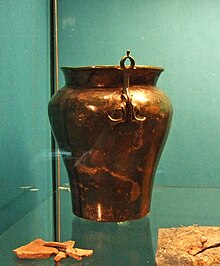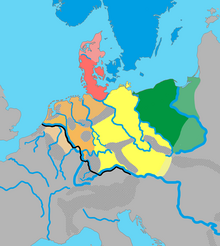31:
253:
39:
104:
229:
descended), there was a relatively uniform development in the economic and social spheres. This can be seen, for example, in the clear consistencies of material and intellectual culture (ceramics, appliances, weapons, jewellery, religious customs, etc.). This was due to the intensive contact between
286:
In the second half of the 20th century, more archeological evidence has emerged. In 1963, the Czech archaeologist Bedřich
Svoboda took up the term and postulated an Elbe Germanic connection with the finds in Bohemia and Bavaria, which was later confirmed.
34:
Urn from a large
Lombard cremation grave field at Putensen, near Harburg, Germany, from the period of 50-375 AD, belonging to the Elbe Germanic culture. This rare metal urn was probably a Roman import
290:
Archaeological finds make it possible to differentiate between the different settlement areas of the Elbe
Germanic tribes. There is a northern group around the mouth of the Elbe and in
294:, a middle group in central Germany that reaches as far as the Oder, and a southern group in Bohemia, an area that was entirely Elbe-Germanic during the time of the Roman Empire.
485:
461:
441:
421:
401:
502:
268:) was first used in 1868 by Paul Gustav Wislicenus (1847-1917), but it was especially popularized by the German prehistorian
30:
328:
252:
453:
413:
393:
202:
All or most of the modern languages thought to derive from the languages of these historical peoples are in the
71:
52:
433:
96:
297:
Based on the linguistic and archaeological evidence, it is believed that the major
Germanic tribes of the
291:
434:
Barbarians within the gates of Rome: a study of Roman military policy and the barbarians, ca. 375-425 A.D
272:
in 1931. The term was based initially on partially speculative derivations from ancient Roman sources.
222:
348:
344:
61:
43:
283:, and some other Germanic tribes of the late antiquity on the Danube limes of the Roman Empire.
143:, clearly the result of a migration up the Elbe river from the northwest in advance of the main
457:
437:
417:
397:
352:
218:
309:
mainly developed from the smaller Suebic groups that were part of the Elbe
Germanic peoples.
374:
340:
144:
38:
489:) (RGA). 2nd edition, Vol. 7, Walter de Gruyter, Berlin/New York 1989, p(p). 107–115.
234:
188:
128:
116:
230:
the Elbe
Germanic tribes, as well as contact with other, more distant, Germanic tribes.
507:
369:
336:
269:
192:
496:
318:
207:
82:
148:
17:
103:
203:
241:
214:
172:
164:
27:
Modern proposed category of peoples speaking dialects ancestral to High German
131:
whose settlement area, based on archaeological finds, lay either side of the
364:
302:
280:
180:
298:
176:
160:
240:
Based on the Roman sources, this cultural area was briefly united under
306:
184:
140:
136:
275:
For example, numerous Roman authors mentioned the tribes such as the
257:
226:
196:
276:
251:
168:
102:
37:
29:
135:
estuary on both sides of the river and which extended as far as
132:
412:
Johannes Hoops, Heinrich Beck, Dieter
Geuenich, Heiko Steuer:
244:(c. 30 BC -- AD 37), a Romanized king of the Germanic Suebi.
183:
or
Herminones mentioned by classical authors such as
414:
179:. Historically they are possibly the same as the
396:; Oldenbourg Wissenschaftsverlag, Munich, 2004,
339:, or dialectal grouping, ancestral to the later
260:from Schwanbeck, Mecklenburg-Vorpommern, Germany
147:until the individual groups ran into the Roman
436:, Indiana University Press, Bloomington 1994,
327:, is a term introduced by the German linguist
213:By contrast with the settlement areas of the
8:
456:; Walter de Gruyter, Berlin/New York, 1999,
159:The Elbe Germans included the tribes of the
486:Reallexikon der Germanischen Altertumskunde
416:; Walter de Gruyter, Berlin/New York 1989,
475:Heinrich Beck, Gerhard Mildenberger:
46:dialect groups in Europe in around AD 1:
385:
481:Lexicon of Germanic Antiquity Studies
195:. The most notable of these were the
7:
454:Germanenprobleme in heutiger Sicht
264:The term 'Elbe Germanic' (German:
25:
42:The distribution of the primary
107:The catchment of the River Elbe
1:
335:, to describe the unattested
323:"Elbe Germanic", also called
313:Elbe Germanic protolanguage
524:
316:
333:Nordgermanen und Alemanen
503:Early Germanic peoples
292:Mecklenburg-Vorpommern
261:
120:
108:
100:
35:
255:
125:Elbe Germanic peoples
106:
41:
33:
72:Weser–Rhine Germanic
256:Elbe Germanic disc
248:History of research
223:Rhine-Weser Germans
18:Elbe Germanic tribe
331:in his 1942 book,
270:de:Walther Matthes
262:
155:Tribal affiliation
109:
101:
62:North Sea Germanic
36:
432:Thomas S. Burns:
210:language family.
16:(Redirected from
515:
464:
450:
444:
430:
424:
410:
404:
390:
375:Germanic peoples
329:Friedrich Maurer
237:have been made.
225:(from which the
145:Migration Period
94:
79:
69:
59:
50:
21:
523:
522:
518:
517:
516:
514:
513:
512:
493:
492:
472:
467:
452:Heinrich Beck:
451:
447:
431:
427:
411:
407:
391:
387:
383:
361:
321:
315:
250:
235:Jastorf culture
233:Links with the
189:Pliny the Elder
157:
151:around 200 AD.
129:Germanic tribes
99:
92:
90:
77:
75:
74:, or Istvaeonic
67:
65:
64:, or Ingvaeonic
57:
55:
48:
28:
23:
22:
15:
12:
11:
5:
521:
519:
511:
510:
505:
495:
494:
491:
490:
471:
468:
466:
465:
445:
425:
405:
384:
382:
379:
378:
377:
372:
370:South Germanic
367:
360:
357:
337:proto-language
317:Main article:
314:
311:
249:
246:
193:Pomponius Mela
156:
153:
91:
76:
66:
56:
53:North Germanic
47:
26:
24:
14:
13:
10:
9:
6:
4:
3:
2:
520:
509:
506:
504:
501:
500:
498:
488:
487:
482:
478:
474:
473:
469:
463:
462:9783110164381
459:
455:
449:
446:
443:
442:9780253312884
439:
435:
429:
426:
423:
422:9783110114454
419:
415:
409:
406:
403:
402:9783486567557
399:
395:
392:Walter Pohl:
389:
386:
380:
376:
373:
371:
368:
366:
363:
362:
358:
356:
354:
350:
346:
342:
338:
334:
330:
326:
320:
319:Elbe Germanic
312:
310:
308:
304:
300:
295:
293:
288:
284:
282:
278:
273:
271:
267:
259:
254:
247:
245:
243:
238:
236:
231:
228:
224:
220:
216:
211:
209:
208:West Germanic
206:group of the
205:
200:
198:
194:
190:
186:
182:
178:
174:
170:
166:
162:
154:
152:
150:
146:
142:
138:
134:
130:
126:
122:
118:
114:
105:
98:
97:East Germanic
89:
85:
84:
83:Elbe Germanic
73:
63:
54:
45:
40:
32:
19:
484:
480:
477:Elbgermanen.
476:
448:
428:
408:
394:Die Germanen
388:
332:
324:
322:
296:
289:
285:
274:
265:
263:
239:
232:
219:Oder-Vistula
212:
201:
158:
149:Danube Limes
124:
113:Elbe Germans
112:
110:
87:
81:
266:Elbgermanen
204:High German
121:Elbgermanen
497:Categories
470:Literature
381:References
355:dialects.
349:Thuringian
305:, and the
242:Maroboduus
173:Marcomanni
165:Hermunduri
365:Irminones
345:Lombardic
341:Alemannic
325:Irminonic
303:Thuringii
281:Irminones
215:North Sea
199:tribes.
181:Irminones
88:Irminonic
359:See also
353:Bavarian
299:Alemanni
279:and the
177:Lombards
175:and the
161:Semnones
44:Germanic
479:In the
307:Bavarii
185:Tacitus
141:Moravia
137:Bohemia
460:
440:
420:
400:
258:fibula
227:Franks
197:Suebic
117:German
95:
93:
80:
78:
70:
68:
60:
58:
51:
49:
508:Suebi
277:Suebi
169:Quadi
127:were
123:) or
86:, or
458:ISBN
438:ISBN
418:ISBN
398:ISBN
351:and
221:and
191:and
139:and
133:Elbe
111:The
499::
347:,
343:,
301:,
217:,
187:,
171:,
167:,
163:,
119::
483:(
115:(
20:)
Text is available under the Creative Commons Attribution-ShareAlike License. Additional terms may apply.


